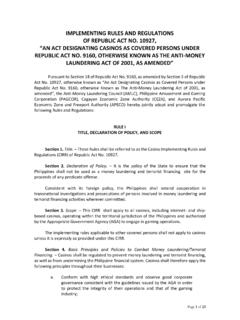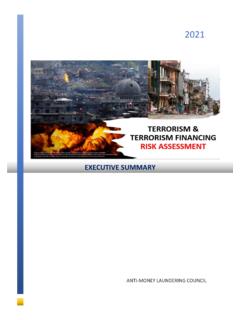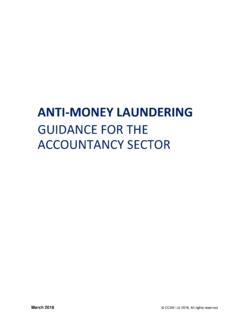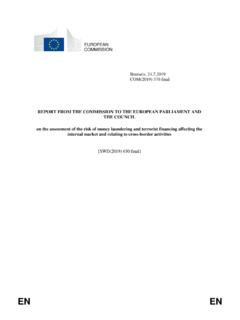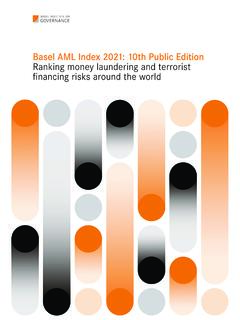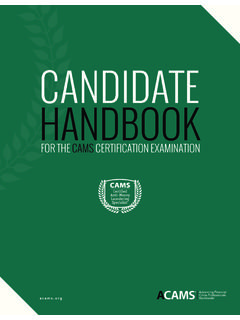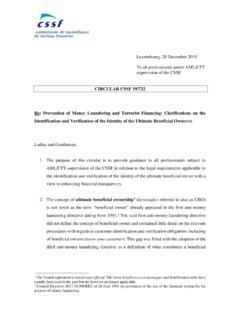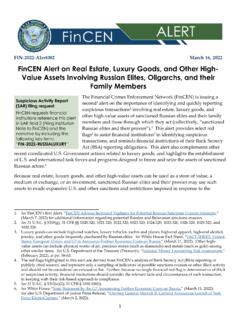Transcription of Designated Non-Financial Businesses and Professions (DNFBPs)
1 Annex A. Republic of the Philippines Anti-Money Laundering Council Designated Non-Financial Businesses and Professions (DNFBPs). 2021 Risk Review on AMLC-Registered DNFBPs and an overview of the Risk-Based Supervisory Framework 2021 Risk Review of AMLC-Registered DNFBPs Table of Contents I. Introduction 3. II. Background . 4. III. Objectives 5. IV. Scope and Data Collection .. 6. V. Limitations .. 6. VI. Assessment Methodology .. 7. VII. Risk-Based Supervisory Framework .. 8. VIII. DNFBP Landscape/Overview 12. 1. Accountants .. 12. 2. Lawyers .. 13. 3. company Service Providers .. 13. 4. Jewelry Dealers and Dealers in Precious Metals and Stones .. 14. 5. Philippine Offshore Gaming Operators Service Providers .. 14. IX. Threat Assessment . 15. X. Vulnerability Assessment .. 19. XI. Overall Vulnerability and Residual Risk 20. XII. Action Plan .. 32. 2. 2021 Risk Review of AMLC-Registered DNFBPs Introduction Over the years, new trends have been used by money launderers and terrorism financiers to disguise the true source of revenues and conceal the purpose of funding activities.
2 As a response to the increasing countermeasures adopted by governments and financial institutions, criminals resort to the use of Non-Financial entities, or Designated Non-Financial Business and Professions (DNFBPs) to continue their illegal practices. As an attractive channel for money laundering and terrorism financing, the risk of misuse of the DNFBPs sector, such as the use of gatekeepers to hide true ownership and control of illegal proceeds, the Financial Action Task Force (FATF) issued guidance for jurisdictions to include this sector under the Anti-Money Laundering and Counter Terrorism Financing (AML/CTF) regime, and develop and implement regulations to prevent or guard the sector against criminal financial activities. FATF Recommendation 28 requires jurisdictions to regulate DNFBPs the same way as financial institutions, and adopt regulations tailored to the risks for each industry. Additionally, FATF issued Recommendation 1 on assessing Risks and applying a risk-based approach on supervision, and released the guidance on risk-based supervision to allow supervisors to focus on processes, according to its understanding of the risks, and effectively allocate its resources and adopt appropriate mechanisms to achieve effective AML/CTF.
3 Supervision. The institutional measures and other means that jurisdictions use to apply risk- based supervision and enforcement should be tailored to each jurisdiction's context. This can include the existing institutional and regulatory framework (such as the prudential regulation of relevant sectors), the size and complexity of the regulated sectors and the degree of Money Laundering/Terrorism Financing (ML/TF) risks (including threats and vulnerabilities) to which they are The role of supervision in an AML/CTF framework is to supervise and monitor covered persons to ensure that their ML/TF risks are managed, and AML/CFT preventive measures are compliant with laws and regulations. Different jurisdictions adopt different measures to ensure compliance by supervised institutions. This Report is an update on the risk and vulnerability assessment of the DNFBPs sector presenting the developments in the regulatory framework, as well as the sector's response to the laws enacted by the government, and the regulations issued by the AMLC.
4 This Report also presents the risk-based supervisory framework adopted by the AMLC in response to Recommendation 1 and supervisory guidance issued by FATF. 1 FATF Guidance on Risk-Based Supervision. 3. 2021 Risk Review of AMLC-Registered DNFBPs Background In the 1st Philippine National Risk Assessment (NRA) covering the period 2011 to 2014, the DNFBP sector was assessed to have Medium to Medium-High ML/TF risks. One of the challenges encountered during the 1 st NRA was the non-cooperation of some DNFBP players due to fear of being targeted for tax purposes. A brief summary of the results2 of the risk and vulnerability assessment of the different sectors in the industry is presented as follows: Sector Vulnerability Assessment Casinos Very High Real Estate Medium/High Jewelry Dealers and Dealers in Precious Medium/High Metals and Stones Lawyers and Notaries Medium Accountants Medium trust and company Service Providers Low and Medium Car Dealers Medium As a response to FATF's recommendation to include the DNFBPs and the casino sector under the AML/CTF regime, Republic Act ( ) Nos.
5 10365 and 10927 were passed in March 2013. and July 2017, respectively, to further amend No. 9160, as amended, otherwise known as Anti-Money Laundering Act of 2001 (AMLA), to include the aforementioned sectors. In its extensive efforts to fight ML and TF and strengthen its AML/CTF regime, the Philippines conducted the 2nd NRA covering the period 2015 to 2016, to update the results of sectoral risks and vulnerability assessments considering regulatory and supervisory developments implemented. Although the 2016 Revised Implementing Rules and Regulation (2016 RIRR). of the AMLA was issued, specific provisions for the DNFBPs were not included. Thus, the identified weaknesses of the covered DNFBPs remained. A summary of the results of the sector's vulnerability assessment in the 2 nd NRA is presented below: Sector Vulnerability Assessment Casinos High Real Estate Medium Jewelry Dealers and Dealers in Precious Medium Metals and Stones Lawyers and Notaries Medium Accountants Medium 2.
6 The 1st Philippine National Risk Assessment. 4. 2021 Risk Review of AMLC-Registered DNFBPs Sector Vulnerability Assessment company Service Providers Medium Car Dealers Medium Another significant development in the Philippines' AML/CTF regime was the passing of No. 11521 in January 2021, which further amended the AMLA, as amended, and extended its coverage to include: 1. Real estate developers and brokers; and 2. Offshore Gaming Operators (OGO), as well as their service providers (SP), supervised, accredited and regulated by Philippine Amusement and Gaming Corporation (PAGCOR) or other Appropriate Government Agencies (AGAs). With the new laws passed, the AMLC issued the 2018 Implementing Rules and Regulations (2018 IRR), which amended the 2016 RIRR, and subsequently issued the 2021 AML/CTF. Guidelines for DNFBPs where the principles therein must be applied by the sector in their Businesses . Objectives Consistent with FATF Recommendation No.
7 1 in Assessing Risk and Applying Risk-Based Approach, the AMLC undertakes this risk review as an update in the sectoral risk and vulnerability assessment of the DNFBP sector, specifically those registered with the Anti- Money Laundering Council Secretariat, with the following objectives: 1. To determine the current ML/TF risk and vulnerability level of the sector after being regulated and covered under the AMLA, as amended;. 2. To assess the level of understanding of the sector of their AML/CTF obligations;. 3. To determine the level of sufficiency of existing AML/CTF controls of the sector to prevent its misuse for ML/TF;. 4. To provide information and guidance to the sector in order to enhance their general understanding of the AML/CTF initiatives;. 5. To guide supervisors in the conduct of risk-based supervision; and 6. To identify potential improvements and action plans for a more effective AML/CFT. compliance regime of the sector.
8 5. 2021 Risk Review of AMLC-Registered DNFBPs Scope and Data Collection This update in the risk and vulnerability assessment which covers the period 2019 to 2021. only includes DNFBPs registered with the AMLC as of 25 May 2021 under the following sectors: a) Jewelry dealers and dealers in precious metals and precious stones, who, as a business, trade in precious stones;. b) company Service Providers (CSP), which as a business, provide any of the services cited in Section 1 of 10365;. c) Lawyers and Accountants who provide the services enumerated under Section 1 of 10365; and d) OGO-SPs, supervised, accredited or regulated by the PAGCOR or AGA. This assessment does not cover Real Estate Brokers, Real Estate Developers, and Casinos, as separate risk assessments have already been conducted on these sectors. The collection of data in this update was conducted through a Risk Assessment and Data Collection Questionnaire (Questionnaire) adopted by the AMLC.
9 Information on the recipients of the Questionnaire was taken from the registration data of the AMLC. The survey questionnaire focuses on qualitative and quantitative information on the DNFBP landscape, ML/TF risks, threats, risk consequences. Information on level of awareness of covered persons of the threats faced by their institution and industry, and the existence of AML/CTF. controls of each of the entities also provided a picture on the current risk and vulnerability level of the sector after it has been covered under the AMLA, as amended. Entities under each DNFBP sector who are registered with the AMLC were given a link to the Questionnaire where they may provide their answers. Responses were then collected, analyzed and summarized to come up with this consolidated Report. Limitations The limitations and challenges encountered in the conduct of this assessment are as follows: 1. Only DNFBPs registered with the AMLA were the recipients of the Questionnaire and do not accurately reflect the entire population of the sector.
10 2. Data source and assessment results are limited to the responses of entities who responded to the Questionnaire;. 3. Not all recipients participated in the survey providing a low response rate of only (66 out of the 214 registered entities). 6. 2021 Risk Review of AMLC-Registered DNFBPs The above limitations do not however invalidate the responses presented in this updated assessment. Assessment Methodology The assessment methodology was patterned after the World Bank Assessment Tool considering the above-mentioned limitations. Overall vulnerability was assessed based on the inherent variables and the AML Control variables. For AML control variables, assessment was made on the AML/CTF controls present in each entity based on the responses provided. The responses also gauged the level of awareness on ML/TF risks and obligation of each sector player. Relatively, with the data gathered from the survey, the inherent vulnerability of each business was identified considering the following available information: 1.


